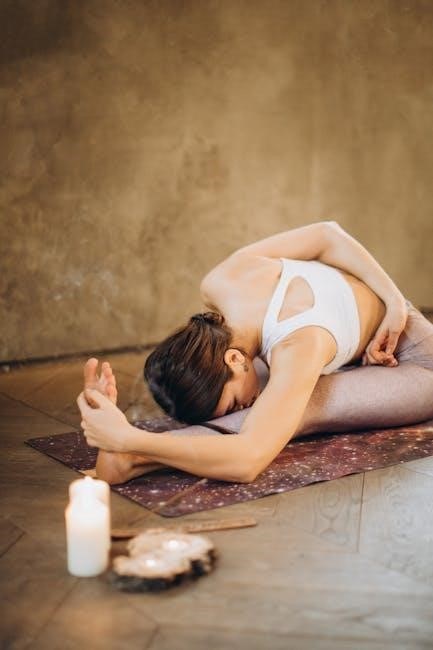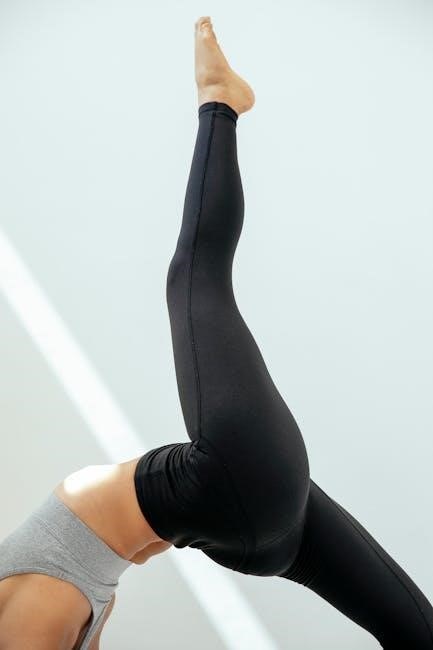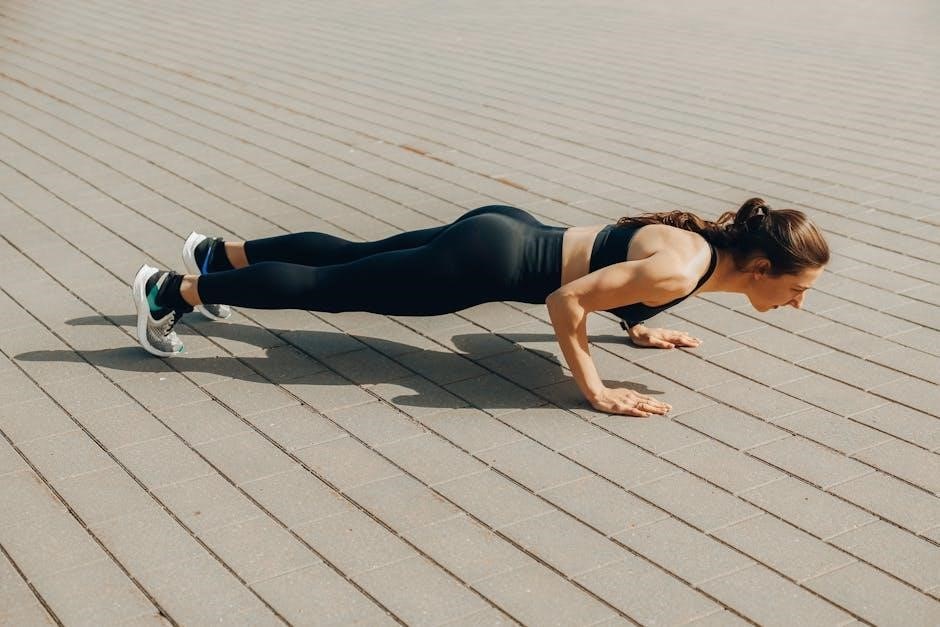The gluteus medius is a vital muscle located on the outer aspect of the hip, playing a crucial role in hip stability and movement․ It is one of three glute muscles, situated between the gluteus minimus and gluteus maximus, and is essential for activities like walking, running, and maintaining proper posture․ This muscle facilitates abduction, medial rotation, and extension of the hip joint, making it indispensable for balanced movement and overall lower body functionality․
1․1․ Anatomy and Function of the Gluteus Medius
The gluteus medius is a fan-shaped muscle located on the outer aspect of the hip, originating from the ilium and inserting into the femur․ It is part of the gluteal group, playing a key role in hip abduction, medial rotation, and extension․ This muscle is divided into two parts: the anterior fibers, which assist in hip flexion and internal rotation, and the posterior fibers, which aid in hip extension and external rotation․ Its primary function is to stabilize the pelvis during walking, ensuring proper gait mechanics․ Weakness in the gluteus medius can lead to poor posture and movement imbalances, such as a Trendelenburg gait, where the pelvis tilts downward on the opposite side of the weak muscle․
Due to its deep location beneath the gluteus maximus, the gluteus medius is often overlooked but is essential for maintaining hip and lower limb alignment․ Its activation is critical during activities like running, climbing stairs, and single-leg balance exercises․ Proper functioning of the gluteus medius ensures efficient energy transfer from the lower limbs to the spine, reducing the risk of overuse injuries and improving overall athletic performance․ Understanding its anatomy and function is the first step in addressing tightness or weakness and incorporating effective stretching and strengthening routines․
1․2․ Importance of the Gluteus Medius in Hip Stability
The gluteus medius is crucial for maintaining hip stability and proper pelvic alignment․ During walking or running, it prevents excessive hip drop on the opposite side, a condition known as a Trendelenburg gait․ This muscle acts as a dynamic stabilizer, ensuring the femoral head remains centered in the acetabulum, which minimizes wear and tear on the hip joint․ Weakness or tightness in the gluteus medius can lead to poor biomechanics, increasing the risk of injuries such as hip impingement, knee pain, or lower back strain․ Strengthening and stretching this muscle are essential for optimal hip function and overall lower limb health․

Why Stretching the Gluteus Medius is Essential
Stretching the gluteus medius prevents tightness, enhances hip mobility, and reduces the risk of lower back, hip, and knee pain, improving overall movement and posture․
2․1․ Common Causes of Tightness in the Gluteus Medius
Tightness in the gluteus medius often results from prolonged sitting, overuse in activities like running or cycling, and muscle imbalances․ Weakness in the gluteus medius can lead to compensatory patterns, causing tightness․ Poor posture, such as an anterior pelvic tilt, further exacerbates the issue․ Additionally, inflammation from injuries or conditions like gluteal tendinopathy can contribute to muscle stiffness․ Addressing these factors through targeted stretching and strengthening exercises is essential to maintain hip health and prevent discomfort․
2․2․ Benefits of Stretching for Hip Health and Mobility
Regular stretching enhances hip flexibility and reduces muscle tension, promoting better joint mobility․ It alleviates tightness in the gluteus medius, lowering the risk of hip and lower back pain․ Stretching improves range of motion, making daily activities and athletic performance more efficient․ Enhanced circulation from stretching delivers oxygen and nutrients to muscles, aiding recovery․ Consistent practice also minimizes muscle imbalances, preventing injuries and maintaining proper posture․ Incorporating stretches into a routine supports overall hip health, ensuring optimal functionality and comfort in movement․

Key Benefits of Gluteus Medius Stretching
Stretching the gluteus medius enhances hip mobility, reduces muscle tension, and prevents lower back pain․ It improves posture, promotes balanced movement, and minimizes the risk of injuries․
3․1․ Prevention of Lower Back, Hip, and Knee Pain
Stretching the gluteus medius helps alleviate tightness that can radiate pain to the lower back, hips, and knees․ Tightness in this muscle often leads to poor posture and movement imbalances, which can strain nearby joints․ By improving flexibility and reducing muscle tension, gluteus medius stretches can significantly lower the risk of developing chronic pain in these areas․ Regular stretching also enhances joint stability, making it easier to maintain proper alignment during daily activities and exercise, thereby preventing discomfort and potential injuries․
3․2․ Improvement in Athletic Performance and Movement
Stretching the gluteus medius enhances athletic performance by improving hip mobility, balance, and power․ This muscle is critical for explosive movements, such as sprinting and jumping, as it stabilizes the hip during dynamic actions․ Tightness in the gluteus medius can limit range of motion and hinder performance, while regular stretching increases flexibility and coordination․ Athletes, particularly runners and cyclists, benefit from reduced muscle stiffness, allowing for more efficient and powerful movements․ Additionally, better hip stability reduces the risk of overuse injuries, enabling athletes to train and compete at higher intensities with improved endurance and overall performance․
3․3․ Reduction of Muscle Imbalances and Injuries
Stretching the gluteus medius helps correct muscle imbalances by strengthening and loosening tight or overactive muscles․ Weakness in this muscle often leads to compensation patterns, increasing the risk of injuries like IT band syndrome or lower back pain․ Regular stretching promotes proper hip alignment and reduces strain on surrounding tissues․ By improving flexibility and strength, it prevents overuse injuries and enhances overall hip stability, which is crucial for runners and cyclists․ Addressing gluteus medius tightness also alleviates knee and lower back pain caused by poor hip mechanics, ensuring a more balanced and injury-resistant lower body․

Best Stretches for the Gluteus Medius
Effective gluteus medius stretches include the Seated Figure Four, Piriformis Figure Four, Cross-Legged Glute Stretch, Pigeon Pose, Hip Drops, and Side-Lying Abduction․ These exercises improve flexibility and reduce muscle tension, promoting better hip mobility and overall lower body alignment․
4․1․ Seated Figure Four Stretch
The Seated Figure Four Stretch is an effective exercise for targeting the gluteus medius․ To perform it, sit on a chair or the floor with a straight back and feet flat․ Cross one ankle over the opposite knee, forming a “figure four” shape․ Gently lean forward from the hips until a stretch is felt in the outer hip․ Hold for 30 seconds and repeat on both sides․ This stretch is particularly beneficial for individuals who spend long hours sitting or experience stiffness from overuse, helping to alleviate tightness and improve hip mobility․
4․2․ Piriformis Figure Four Stretch
The Piriformis Figure Four Stretch targets both the piriformis and gluteus medius muscles․ Lie on your back and cross the affected leg over the opposite thigh, forming a “figure four” position․ Gently pull the unaffected leg toward your chest until a stretch is felt in the buttock area․ Hold for 30 seconds and repeat on the other side․ This stretch is ideal for addressing tightness and discomfort in the outer hip, often caused by prolonged sitting or overuse, and helps improve hip joint mobility and reduce muscle tension․
4․3․ Cross-Legged Glute Stretch
The Cross-Legged Glute Stretch is an effective way to target the gluteus medius and improve hip mobility․ Sit on the floor with your legs crossed, placing one ankle over the opposite knee․ Gently lean forward from your hips until a stretch is felt in the outer hip area․ Maintain a straight back and avoid rounding your spine․ Hold the stretch for 30 seconds and switch sides․ This stretch is particularly beneficial for individuals with tight hips from sitting or repetitive movements, helping to alleviate tension and enhance range of motion․
4․4․ Pigeon Stretch Pose
The Pigeon Stretch Pose is a popular yoga-inspired stretch that targets the gluteus medius and hip flexors․ Start on all fours, then bring one knee forward, placing your ankle near the opposite knee․ Lower your hips down, stretching the back leg’s hip․ Keep your spine straight and hold for 30 seconds․ This stretch helps relieve tightness, improves hip mobility, and reduces lower back tension; It’s especially beneficial for athletes and individuals with sedentary lifestyles, promoting balanced hip function and reducing injury risk․ Proper breathing enhances the stretch’s effectiveness, ensuring a deep release in the gluteus medius muscle․
4․5․ Hip Drops
Hip Drops are an effective stretch for targeting the gluteus medius, focusing on the outer hip and hip joint․ To perform, lie on your side with knees bent and ankles together․ Slowly drop the top knee toward your opposite shoulder, stretching the hip․ Hold for 30 seconds and repeat on the other side․ This stretch improves hip mobility, reduces tightness, and enhances flexibility in the gluteus medius․ It’s particularly beneficial for runners and cyclists, helping to alleviate strain and prevent muscle imbalances․ Proper form ensures maximum benefits without discomfort․
4․6․ Side-Lying Abduction Stretch
The Side-Lying Abduction Stretch targets the gluteus medius, promoting hip mobility and flexibility․ Lie on your side with legs straight, feet touching․ Lift the top leg away from the bottom, keeping it straight, until a gentle stretch is felt․ Hold for 20-30 seconds, then lower slowly․ Repeat 2-3 times on each side․ This stretch is ideal for improving range of motion and reducing tightness in the outer hip․ It’s particularly effective for runners and cyclists, helping to prevent muscle imbalances and enhance athletic performance․ Proper execution ensures optimal benefits for hip health and mobility․

Step-by-Step Guide to Performing Each Stretch
Master each stretch with precision․ Start with proper alignment, engage the target muscle, and hold stretches for 20-30 seconds․ Breathe deeply, avoiding force or pain, for optimal results․
5․1․ Proper Technique for the Seated Figure Four Stretch
Sit on a chair or the floor with a straight back and feet flat․ Cross one ankle over the opposite knee, forming a “figure four” shape․ Gently press the knee away from you until a stretch is felt in the outer hip․ Maintain a neutral pelvis and avoid rounding the back․ Hold for 20-30 seconds, breathing deeply to relax the muscle․ Repeat on the other side․ This stretch is ideal for relieving tightness from prolonged sitting and improves hip mobility․ Perform it gently to avoid discomfort or strain․
5․2․ How to Perform the Piriformis Figure Four Stretch Safely
Begin by sitting on the floor with your legs extended․ Cross one ankle over the opposite knee, forming a “figure four” position․ Gently press the knee toward your chest until a stretch is felt in the outer hip and buttock․ Keep your back straight and avoid forcing the stretch․ Hold for 20-30 seconds, breathing deeply to relax the muscle․ If discomfort arises, modify the stretch by reducing pressure or using a strap to support the leg․ Perform on both sides to ensure balanced flexibility and relief from piriformis tightness․
5․3․ Execution of the Cross-Legged Glute Stretch
Sit on the floor with your legs crossed, bringing one ankle to rest on the opposite knee․ Place your hands on the knee of the crossed leg and gently press it outward to deepen the stretch․ Keep your back straight and engage your core to maintain stability․ Hold for 20-30 seconds, focusing on deep breaths to relax the muscle․ If tightness is severe, use a strap or towel to assist․ This stretch targets the gluteus medius and piriformis, promoting flexibility and relief from tension in the outer hip area․ Repeat on both sides for balanced results․
5․4․ Mastering the Pigeon Stretch Pose
Begin on all fours, then bring one knee forward, placing your ankle just below your opposite knee․ Extend the other leg behind you, keeping your hips level and back straight․ Lower your torso to the ground, extending your arms in front for support․ For deeper relaxation, place a cushion under your hip if needed․ Hold for 20-30 seconds, breathing deeply to enhance the stretch․ This pose effectively targets the gluteus medius and piriformis, helping to alleviate hip tightness and lower back pain․ Switch sides to ensure balanced flexibility and muscle relief․
5․5․ Correct Form for Hip Drops
Stand sideways near a stable object for balance, feet hip-width apart․ Shift your weight onto one leg, keeping the other foot lifted slightly off the ground․ Slowly lower the hip of the non-weight-bearing side downward, allowing it to “drop” while maintaining a neutral spine and upper body stability․ Ensure the movement is controlled and avoid bouncing․ Hold for 2-3 seconds before returning to the starting position․ Perform 10-15 repetitions on each side․ This stretch targets the gluteus medius, enhancing hip mobility and reducing stiffness․ Proper form is crucial to maximize effectiveness and prevent discomfort․
5․6․ Tips for Effective Side-Lying Abduction Stretch
Begin by lying on one side with legs extended and feet touching․ Engage your core and maintain a neutral spine․ Slowly lift the top leg away from the bottom leg, keeping it straight, and hold for 20-30 seconds․ Avoid arching your back or using momentum․ Complete 2-3 repetitions on each side․ Focus on controlled movements to target the gluteus medius effectively․ Proper alignment and steady breathing are key to maximizing the stretch’s benefits․ Ensure the movement is smooth and pain-free to avoid injury and enhance hip mobility․

When to Incorporate Gluteus Medius Stretches
Incorporate gluteus medius stretches during pre-workout warm-ups, post-workout cool-downs, and as part of daily routines, especially for sedentary individuals, to maintain hip mobility and prevent tightness․
6;1․ Pre-Workout Warm-Up Routine
Incorporating gluteus medius stretches into your pre-workout routine enhances hip mobility and prepares the muscle for physical activity․ Begin with dynamic movements like leg swings or hip circles to increase blood flow․ Follow with static stretches such as the seated figure-four or cross-legged glute stretch, holding each for 20-30 seconds․ This routine reduces the risk of injury and improves performance during exercises, especially those involving hip abduction and rotation․ Consistency in this practice ensures better flexibility and readiness for workouts․
6․2․ Post-Workout Cool-Down Stretching
Post-workout stretching is essential for relaxing the gluteus medius after physical activity․ It helps reduce muscle tension, improve recovery, and prevent tightness․ Focus on static stretches like the pigeon stretch, seated figure-four, or cross-legged glute stretch․ Hold each stretch for 20-30 seconds to maximize relaxation․ Incorporating these stretches after exercise enhances flexibility and reduces muscle soreness․ Consistency in post-workout stretching promotes long-term hip health and mobility, ensuring the gluteus medius remains flexible and functional․ This practice is particularly beneficial for athletes or individuals engaging in repetitive hip movements during their workouts․
6․3․ Daily Stretching for Sedentary Individuals
Daily stretching is crucial for sedentary individuals to counteract the effects of prolonged sitting, which can lead to gluteus medius tightness and weakness․ Incorporating simple stretches like the seated figure-four or cross-legged glute stretch can improve hip mobility and reduce the risk of muscle imbalances․ Even 5-10 minutes of stretching per day can enhance blood flow, alleviate stiffness, and promote better posture․ Consistency is key, as regular stretching helps maintain hip health and prevents long-term issues associated with inactivity․ This routine is especially beneficial for those with desk jobs or limited physical activity․

Common Mistakes to Avoid During Stretching
Common mistakes include overstretching, improper breathing, and using forced movements, which can lead to injury or reduced effectiveness of the stretch․ Proper technique is essential․
7․1․ Overstretching and Its Consequences
Overstretching can cause micro-tears in the muscle fibers, leading to pain and stiffness․ It may also reduce the effectiveness of the stretch and delay recovery․ Proper form and gentle holds are crucial to avoid injury and ensure benefits․ Overstretching can create instability in the hip joint, potentially leading to poor posture or movement patterns․ Listening to your body and not pushing beyond a comfortable range is key to safe and effective stretching․ Consistency and patience yield better results than aggressive overstretching․
7․2․ Importance of Proper Breathing Techniques
Proper breathing is essential during gluteus medius stretches to ensure relaxation and maximize the effectiveness of the exercise․ Deep, controlled breaths help maintain focus and prevent muscle tension, allowing for a deeper stretch․ Inhale before starting the stretch and exhale slowly as you ease into it, using the breath to release tightness gently․ Avoid holding your breath, as this can increase tension and reduce flexibility․ Consistent, rhythmic breathing enhances circulation, delivering oxygen to the muscles and promoting recovery․ Synchronizing breath with movement ensures a safer and more beneficial stretching experience․
7․3; Avoiding Bouncing or Forced Movements
Avoiding bouncing or forced movements during gluteus medius stretches is crucial to prevent muscle strain or injury․ Bouncing can cause micro-tears in the muscle fibers, leading to increased soreness and prolonged recovery․ Similarly, forcing a stretch beyond a comfortable range can overstretch ligaments or tendons, compromising joint stability․ Instead, focus on smooth, controlled movements, holding stretches at a gentle, static position․ This approach ensures safe and effective stretching, promoting flexibility without risking damage․ Proper technique and patience are key to achieving long-term benefits for hip health and overall mobility․

Incorporating Gluteus Medius Stretches into Your Routine
Incorporating gluteus medius stretches into your routine is essential for maintaining hip health․ Perform 3-5 stretches 3-4 times weekly, ideally as a warm-up or post-workout․ Combine with strengthening exercises for overall hip health and mobility․
8․1․ Frequency and Duration of Stretching Sessions
For optimal results, incorporate gluteus medius stretches 3-4 times weekly, with 3-5 stretches per session․ Each stretch should be held for 30 seconds and repeated 2-3 times on each side․ Consistency is key to improving flexibility and reducing muscle tension; Start with shorter sessions and gradually increase duration as comfort allows․ Always warm up with light cardio or dynamic movements before stretching to enhance effectiveness․ Tracking progress and adjusting routines based on muscle response ensures long-term benefits for hip health and mobility․
8․2․ Combining Stretches with Strengthening Exercises
Combining gluteus medius stretches with strengthening exercises enhances muscle balance and overall hip function․ Strengthening exercises like side-lying abductions, single-leg bridges, and resisted hip abductions complement stretching by improving muscle activation․ This dual approach reduces injury risk and boosts athletic performance․ Perform strengthening exercises 2-3 times weekly, using resistance bands or bodyweight for added intensity; Pairing these with regular stretching ensures a well-rounded routine that promotes both flexibility and strength, essential for maintaining proper hip alignment and movement efficiency․
8․3․ Tracking Progress and Adjusting Your Routine
Regularly tracking progress in your gluteus medius stretching routine is essential for achieving optimal results․ Monitor improvements in flexibility, range of motion, and reduced muscle tightness․ Adjust the frequency, duration, or intensity of stretches based on your progress․ Incorporate strengthening exercises and modify stretches as needed to target specific areas․ Tailor your routine to address personal goals, such as enhanced athletic performance or improved posture․ Schedule periodic assessments to ensure continuous improvement and maintain a balanced approach to hip health․ Adjustments should be gradual and aligned with your body’s responses to the exercises․
